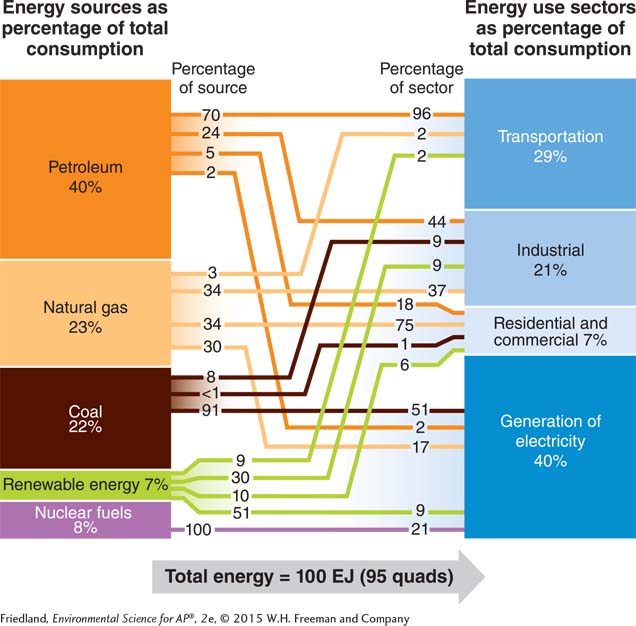Chapter 13 AP® Environmental Science Practice Exam
Section 1: Multiple-
Choose the best answer for questions 1–
Question 1
1. Which of the following is NOT an example of a potentially renewable or nondepletable energy source?
Hydroelectricity
Solar energy
Nuclear energy
Wind energy
Geothermal energy
Question 2
2. Renewable energy sources are best described as
those that are the most cost-
effective and support the largest job market. those that are, or can be, perpetually available.
those that are dependent on increasing public demand and decreasing supply.
those that are being depleted at a faster rate than they are being replenished.
those that are reusable, and therefore eliminate waste energy released into the environment.
Question 3
3. An energy-
building materials with low thermal mass.
a green roof.
southern exposure with large double-
paned windows. reused or recycled construction materials.
photovoltaic solar cells as a source of electricity.
Question 4
4. Which source of energy is NOT (ultimately) solar-
Wind
Biomass
Tides
Coal
Hydroelectricity
Question 5
5. Which of the following demonstrate(s) the use of passive solar energy?
A south-
facing room with stone walls and floors Photovoltaic solar cells for the generation of electricity
A solar oven
I only
II only
III only
I and III
II and III
Question 6
6. A study of small wind turbines in the Netherlands tested the energy output of several models. The results for two models are shown in the graphs below. Which statement can be inferred from these data?
As wind speed increases, energy output decreases.
The annual energy output of model 1 can exceed 6,000 kWh.
As energy output surpasses 50 kWh per week, noise pollution increases.
Model 2 is likely to cause more bird and bat deaths.
Model 1 is more cost-
effective.

Question 7
7. The primary sources of renewable energy in the United States are
solar and wind energy.
hydroelectricity and tidal energy.
biomass and hydroelectricity.
geothermal and tidal energy.
wind and geothermal energy.
Question 8
8. The environmental impacts of cutting down a forest to obtain wood as fuel for heating and cooking could include
deforestation and subsequent soil erosion.
release of particulate matter into the air.
a large net rise in atmospheric concentrations of sulfur dioxide.
I only
II only
III only
I and II
II and III

Use the diagram above, which represents annual U.S. energy consumption by source and sector for 2007, to respond to questions 9 and 10.
Question 9
9. Which statement best describes the sources of energy in U.S. energy consumption patterns?
Most of the renewable energy is used in the industrial, residential, and commercial sectors.
Most of the electricity generated in the United States comes from nuclear energy.
The industrial sector is heavily dependent on coal and renewable energy.
Fossil fuels continue to be the major energy source for all sectors.
The transportation sector uses the greatest amount of energy.
Question 10
10.Which best describes U.S. energy use?
Transportation is the largest end use of energy in the United States.
Transportation is fueled mainly by coal.
Electricity generation is the largest end use of energy in the United States.
Electricity generation is powered mainly by nuclear energy.
Industry is the largest end use of energy in the United States.
Question 11
11.Which statement best describes the role of renewable energy in the United States?
It is the dominant source of energy.
It is the largest contributor of greenhouse gases.
It is a large contributor to the transportation sector.
Its largest contribution is to the electricity generation sector.
It is never sustainable.
Question 12
12.What is the fuel source for a flex-
Electricity
Biodiesel
E-
85 Solar
Cellulose
Question 13
13.In order to best achieve energy sustainability, humans must consider which of the following strategies?
Building large, centralized power plants
Improving energy efficiency
Developing new energy technologies
I only
II only
III only
I and II
II and III
Section 2: Free-
Write your answer to each part clearly. Support your answers with relevant information and examples. Where calculations are required, show your work.
Question 1
1. Hydroelectricity provides about 7 percent of the electricity generated in the United States.
Explain how a hydroelectric power plant converts energy stored in water into electricity. (2 points)
Identify two factors that determine the amount of electricity that can be generated by an individual hydroelectric power plant. (2 points)
Describe the two main types of land-
based hydroelectric power plants. (2 points) Describe two economic advantages and two environmental disadvantages of hydroelectricity. (4 points)
Question 2
2. The following table shows the amounts of electricity generated by photovoltaic solar cells and by wind in the United States from 2002 to 2007 (in thousands of megawatt-
| Energy Source | Year | |||||
| 2002 | 2003 | 2004 | 2005 | 2006 | 2007 | |
| PV Solar Cells | 555 | 534 | 575 | 550 | 508 | 606 |
| Wind | 10,354 | 11,187 | 14,143 | 17,810 | 26,589 | 32,143 |
Describe the trend in electricity generation by photovoltaic solar cells from 2002 to 2007. Calculate the approximate percentage change between 2002 and 2007. (2 points)
Describe the trend in electricity generation by wind from 2002 to 2007. Calculate the approximate percentage change between 2002 and 2007. (2 points)
Identify and explain any difference between the two trends you described in (a) and (b). (2 points)
A homeowner wants to install either photovoltaic solar cells or wind turbines to provide electricity for her home in Nevada, which gets both ample sunlight and wind. Provide two arguments in favor of installing one of these technologies, and explain two reasons for not choosing the other. (2 points)
Would the installation of either PV solar cells or wind turbines be considered an application of energy conservation or of energy efficiency? Explain. (2 points)